Vascular damage effect of circulating microparticles in patients with ACS is aggravated by type 2 diabetes
- PMID: 33899122
- PMCID: PMC8097757
- DOI: 10.3892/mmr.2021.12113
Vascular damage effect of circulating microparticles in patients with ACS is aggravated by type 2 diabetes
Abstract
As a common factor of both type 2 diabetes mellitus (T2DM) and acute coronary syndrome (ACS), circulating microparticles (MPs) may provide a link between these two diseases. The present study compared the content and function of MPs from patients with ACS with or without T2DM. MPs from healthy subjects (n=20), patients with ACS (n=24), patients with T2DM (n=20) and patients with combined ACS and T2DM (n=24) were obtained. After incubating rat thoracic tissue with MPs, the effect of MPs on endothelial‑dependent vasodilatation, expression of caveolin‑1 and endothelial nitric oxide synthase (eNOS), phosphorylation of eNOS at the S1177 and T495 sites and its association with heat shock protein 90 (Hsp90), and the generation of NO and superoxide anion (O2˙‑) were determined. MP concentrations were higher in patients with T2DM and patients with ACS with or without T2DM than in healthy subjects. Moreover, MPs from patients with T2DM or ACS led to impairment in endothelial‑dependent vasodilatation, decreased expression of NO, as well as eNOS and its phosphorylation at Ser1177 and association with Hsp90, but increased eNOS phosphorylation at T495, caveolin‑1 expression and O2˙‑ generation. These effects were strengthened by MPs from patients with ACS combined with T2DM. T2DM not only increased MP content but also resulted in greater vascular impairment effects in ACS. These results may provide novel insight into the treatment of patients with ACS and T2DM.
Keywords: acute coronary syndrome; circulating microparticles; endothelial dysfunction; vascular injury.
Conflict of interest statement
The authors declare that they have no competing interests.
Figures

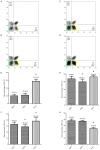
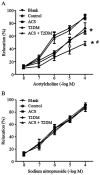
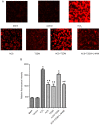
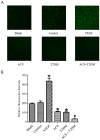
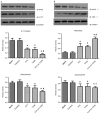

Similar articles
-
Microparticles from Patients with the Acute Coronary Syndrome Impair Vasodilatation by Inhibiting the Akt/eNOS-Hsp90 Signaling Pathway.Cardiology. 2015;132(4):252-60. doi: 10.1159/000438782. Cardiology. 2015. PMID: 26329646
-
Microparticles from Patients Undergoing Percutaneous Coronary Intervention Impair Vasodilatation by Uncoupling Endothelial Nitric Oxide Synthase.Shock. 2017 Aug;48(2):201-208. doi: 10.1097/SHK.0000000000000823. Shock. 2017. PMID: 28002238 Clinical Trial.
-
Circulating microparticles from patients with valvular heart disease and cardiac surgery inhibit endothelium-dependent vasodilation.J Thorac Cardiovasc Surg. 2015 Sep;150(3):666-72. doi: 10.1016/j.jtcvs.2015.05.069. Epub 2015 Jun 5. J Thorac Cardiovasc Surg. 2015. PMID: 26145768
-
Dynamic role of microparticles in type 2 diabetes mellitus.Curr Diabetes Rev. 2009 Nov;5(4):245-51. doi: 10.2174/157339909789804404. Curr Diabetes Rev. 2009. PMID: 19531024 Review.
-
Regulation of endothelial derived nitric oxide in health and disease.Mem Inst Oswaldo Cruz. 2005 Mar;100 Suppl 1:15-8. doi: 10.1590/s0074-02762005000900004. Epub 2005 Jun 14. Mem Inst Oswaldo Cruz. 2005. PMID: 15962093 Review.
Cited by
-
Combination of TyG Index and GRACE Risk Score as Long-Term Prognostic Marker in Patients with ACS Complicated with T2DM Undergoing PCI.Diabetes Metab Syndr Obes. 2022 Sep 28;15:3015-3025. doi: 10.2147/DMSO.S376178. eCollection 2022. Diabetes Metab Syndr Obes. 2022. PMID: 36196143 Free PMC article.
-
Effect of Thrombolysis on Circulating Microparticles in Patients with ST-Segment Elevation Myocardial Infarction.Cardiovasc Ther. 2023 Nov 18;2023:5559368. doi: 10.1155/2023/5559368. eCollection 2023. Cardiovasc Ther. 2023. PMID: 38024103 Free PMC article.
-
Circulating Microvesicles Enriched in miR-126-5p and miR-223-3p: Potential Biomarkers in Acute Coronary Syndrome.Biomedicines. 2025 Feb 18;13(2):510. doi: 10.3390/biomedicines13020510. Biomedicines. 2025. PMID: 40002921 Free PMC article.
-
TYG Index as a Novel Predictor of Clinical Outcomes in Advanced Chronic Heart Failure with Renal Dysfunction Patients.Clin Interv Aging. 2024 Apr 29;19:639-654. doi: 10.2147/CIA.S462542. eCollection 2024. Clin Interv Aging. 2024. PMID: 38706634 Free PMC article.
-
The role of microparticles in oxidative stress and inflammation in patients with vascular intimal hyperplasia.J Int Med Res. 2025 Aug;53(8):3000605251364781. doi: 10.1177/03000605251364781. Epub 2025 Aug 12. J Int Med Res. 2025. PMID: 40794424 Free PMC article.
References
-
- Gach O, El HZ, Lancellotti P. Acute coronary syndrome. Rev Med Liege. 2018;73:243–250. (In French) - PubMed
MeSH terms
Substances
LinkOut - more resources
Full Text Sources
Other Literature Sources
Medical
Molecular Biology Databases
Research Materials

